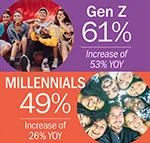 Maya Maroto Maya Maroto |
The concept of “food is medicine” is gaining traction, underscoring the power of dietary choices in enhancing health and preventing illness. This movement, rooted in the synergy between nutrition and healthcare, has yet to be fully leveraged within the U.S. healthcare landscape. By integrating produce prescription programs, medically tailored meals and culturally sensitive nutrition education into healthcare delivery, we stand on the cusp of a transformative approach to health and wellness.
The Biden–Harris administration has spotlighted the “food is medicine” concept within its National Strategy on Hunger, Nutrition and Health, aiming to align our healthcare system with the nutritional needs of the populace. Research from the Tufts Food is Medicine Institute highlights the staggering potential of this approach: National implementation of food is medicine could reduce hospitalizations by 1.6 million and save approximately $13.6 billion in healthcare costs annually. With 23 states exploring or using Medicaid waivers for nutrition programs and the Veterans Administration piloting initiatives, the federal embrace of this concept is expanding.
The convergence of health payors, academia, nonprofits and government on nutrition as a pillar of health management opens an unparalleled opportunity for PR and Communications professionals. We must forge the narratives, build awareness and facilitate partnerships that will shape the future of food is medicine.
Below are several strategies for public relations success in the growing food is medicine movement.
| This article is featured in O'Dwyer's Mar. '24 Food & Beverage PR Magazine (view PDF version) |
Cultivate the narrative
According to the American Medical Association, on average, U.S. medical schools offer only about 19 hours of nutrition education across four years of medical education, corresponding to less than one percent of the estimated total lecture hours. The food is medicine movement calls on physicians, physician’s assistants and nurse practitioners to become more involved in educating their clients on nutrition. Enter the field of “culinary medicine.” Culinary medicine aims to train medical professionals to blend nutrition science and culinary skills with the practice of medicine. More than 50 medical schools are including culinary medicine in their training and research shows that culinary medicine boosts medical professionals’ knowledge, skills, attitudes and confidence in patient nutrition education.
PR and communications professionals—notably at specialized agencies with registered dietitians and public health experts on staff—should provide clients with insights on creating impactful, evidence-based messages for culinary nutrition training. PR professionals with nutrition expertise can help work with the food industry and scientists to navigate the best ways to engage in the dialogue at culinary medicine conferences and contribute to curriculum development to ensure the inclusion of balanced, science-backed dietary advice.
Broaden the lens
A 2021 article published in Advances in Nutrition that examined the available evidence on the impact of healthy food prescription programs on dietary behavior and cardiovascular health concluded: “The focus of most healthy food prescriptions so far has been on fruit and vegetables. Other dietary components, including nuts, beans, whole grains and fish are recognized as important for cardiometabolic health and the impact of including these dietary components remains to be evaluated.” There’s tremendous white space to broaden the food is medicine evidence base and guidance beyond only the provision of fruits and vegetables and to include other nutrient-dense foods such as protein foods, dairy and whole-grains, as well as research-based dietary patterns such as low-carbohydrate, Mediterranean or other non-Eurocentric eating patterns that are known to promote health. PR and communications professionals credentialed in nutrition and public health can play a pivotal role in amplifying the need for inclusive food is medicine research and recommendations that accommodate a variety of foods, thus embracing a holistic, evidence-based approach.
Champion equity and personalized nutrition perspectives
Addressing nutritional needs across different life stages and socioeconomic backgrounds is crucial for the inclusivity of food is medicine programs. For instance, research shows that iron deficiency is common among young children, women of reproductive age and pregnant women in the U.S. and is even worse for individuals of lower socioeconomic status. This deficiency begs for programming that evaluates the impact of food is medicine programs emphasizing iron-rich foods such as fortified breakfast cereals, seafood and beef in populations that could benefit from additional sources of iron. PR and communications professionals with nutrition training and expertise can work with clients to examine the culture and nutritional needs of populations, particularly those at the highest risk of nutrition-related chronic disease, and develop and test food is medicine solutions to meet the personalized needs of key communities.
The American Heart Association, Rockefeller Foundation and Tufts Food is Medicine Institute are investing heavily in food is medicine research and programming. Groups that wish to explore a more comprehensive food is medicine “food basket” must begin executing programs and collecting solid data to make their case—and broaden the narrative to advance a more inclusive future of what foods should be prioritized as medicine.
As we navigate the evolving landscape of food is medicine, the role of strategic communications leveraging the expertise of credentialed health and nutrition experts becomes increasingly vital. By shaping compelling narratives, advocating for comprehensive research and recommendations, and championing equity, PR professionals can help advance a movement that promises a healthier future for all.
***
Maya Maroto, EdD, MPH, RD, is a Vice President at FoodMinds, a division of Padilla, based in the Washington, D.C. office. She leads the agency’s Food is Medicine and Precision Nutrition team.


 What the biggest meal of the day can teach us about serving up effective nutrition communications campaigns.
What the biggest meal of the day can teach us about serving up effective nutrition communications campaigns. Tips to refine and amplify your CPG brand strategy to win in 2024 and beyond.
Tips to refine and amplify your CPG brand strategy to win in 2024 and beyond. How brands can authentically communicate sustainability issues and create a brand experience that’s compatible with consumers’ values.
How brands can authentically communicate sustainability issues and create a brand experience that’s compatible with consumers’ values. Communicating the effects that climate change and a growing world population have on our food system—and why change is needed.
Communicating the effects that climate change and a growing world population have on our food system—and why change is needed. More younger Americans are abstaining from alcohol, according to recent research on the growing sober-curious movement, presenting a challenge—and an opportunity—for beverage marketers in 2024.
More younger Americans are abstaining from alcohol, according to recent research on the growing sober-curious movement, presenting a challenge—and an opportunity—for beverage marketers in 2024.


 Have a comment? Send it to
Have a comment? Send it to 
No comments have been submitted for this story yet.